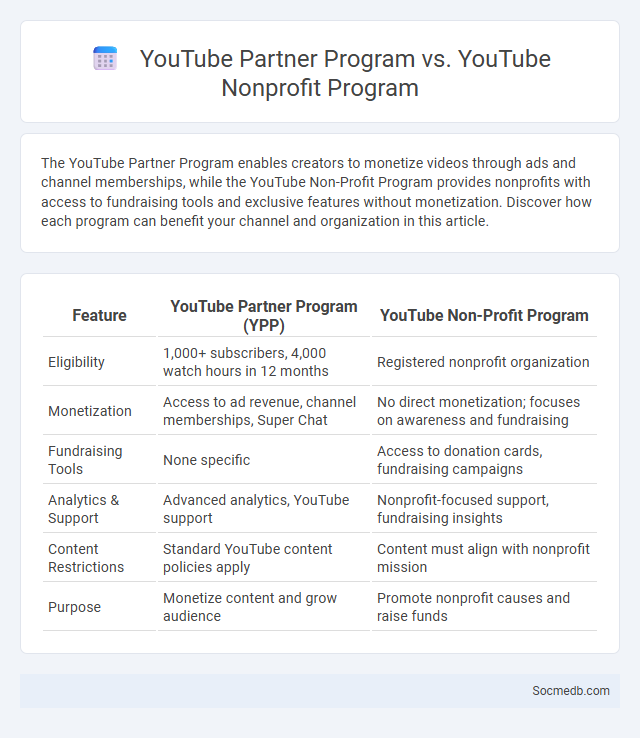
Photo illustration: YouTube Partner Program vs YouTube Non-Profit Program
The YouTube Partner Program enables creators to monetize videos through ads and channel memberships, while the YouTube Non-Profit Program provides nonprofits with access to fundraising tools and exclusive features without monetization. Discover how each program can benefit your channel and organization in this article.
Table of Comparison
| Feature | YouTube Partner Program (YPP) | YouTube Non-Profit Program |
|---|---|---|
| Eligibility | 1,000+ subscribers, 4,000 watch hours in 12 months | Registered nonprofit organization |
| Monetization | Access to ad revenue, channel memberships, Super Chat | No direct monetization; focuses on awareness and fundraising |
| Fundraising Tools | None specific | Access to donation cards, fundraising campaigns |
| Analytics & Support | Advanced analytics, YouTube support | Nonprofit-focused support, fundraising insights |
| Content Restrictions | Standard YouTube content policies apply | Content must align with nonprofit mission |
| Purpose | Monetize content and grow audience | Promote nonprofit causes and raise funds |
Introduction to YouTube Monetization Options
YouTube offers various monetization options including AdSense revenue, channel memberships, Super Chat, and merchandise shelf integrations. By enabling monetization features, your videos can generate income through ads, viewer contributions, and direct sales. Understanding these tools empowers you to diversify revenue streams and maximize earnings on the platform.
Overview of the YouTube Partner Program
The YouTube Partner Program enables creators to monetize their content through ads, channel memberships, and Super Chat. To qualify, your channel must have at least 1,000 subscribers and 4,000 watch hours in the past 12 months, adhering to YouTube's monetization policies. This program offers a significant opportunity to generate revenue while growing your audience and enhancing engagement.
Understanding the YouTube Non-Profit Program
The YouTube Non-Profit Program provides eligible organizations access to tools that enhance their online presence, including donation cards and custom donate buttons integrated directly into videos. Non-profits must meet YouTube's eligibility criteria, such as being registered as a charity, to unlock benefits that improve fundraising and engagement. Leveraging these specialized features helps non-profits effectively connect with audiences and amplify their social impact on the platform.
Partner Program: Types and Eligibility Criteria
The Partner Program in social media platforms varies by type, including content creators, influencers, and business partners, each with distinct eligibility criteria based on follower count, engagement rates, and content quality. Eligibility often requires meeting minimum subscriber thresholds, adhering to community guidelines, and consistent content production aligned with platform policies. Platforms like YouTube, Facebook, and Instagram offer tailored programs with specific metrics such as watch time, video views, or branded content approval to qualify for monetization and collaboration opportunities.
Key Benefits of the YouTube Partner Program
The YouTube Partner Program enables content creators to monetize their videos through ads, channel memberships, and Super Chats, generating a steady income stream. By joining, you gain access to advanced analytics and creator tools that enhance content performance and audience engagement. Exclusive support and promotional opportunities further amplify your channel's growth and visibility on the platform.
Advantages of the YouTube Non-Profit Program
The YouTube Non-Profit Program offers organizations enhanced visibility by providing access to donation cards, fundraising tools, and premium features like live streaming and call-to-action overlays, which increase audience engagement and fundraising potential. You can leverage these tools to build a stronger online presence and connect with a global audience passionate about your cause. Increased donations and support ultimately amplify your nonprofit's impact through targeted storytelling and community interaction.
Application Process and Requirements Compared
Social media platforms often require users to complete a streamlined application process that includes providing personal information, verifying identity, and agreeing to terms of service. Requirements can vary significantly between platforms, ranging from age restrictions and content guidelines to specific data privacy consents. Your successful registration depends on meeting each platform's unique criteria, ensuring compliance and access to full social media features.
Revenue Generation: Monetization Features Breakdown
Social media platforms generate revenue through multiple monetization features including targeted advertising, in-app purchases, and subscription services. Advertising revenue dominates, leveraging user data to deliver personalized ads via formats like sponsored posts, video ads, and stories. Emerging models such as creator monetization tools, brand partnerships, and e-commerce integrations contribute to diversified revenue streams, enhancing overall platform profitability.
Support, Resources, and Community Tools
Social media platforms offer extensive support through dedicated help centers, live chat options, and AI-powered assistance to resolve user issues swiftly. A wealth of resources including tutorials, FAQs, and policy guides empower users to navigate features effectively and maintain account security. Community tools such as groups, forums, and interactive events foster engagement, knowledge-sharing, and peer support among diverse user bases.
Choosing the Right Program: Which is Best for You?
Choosing the right social media program depends on your goals, target audience, and content style. Platforms like Instagram excel in visual storytelling, while LinkedIn suits professional networking and B2B marketing. Understanding your unique needs helps you select the best program to maximize engagement and achieve your social media objectives.
 socmedb.com
socmedb.com